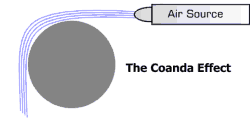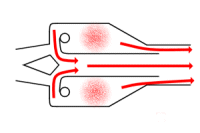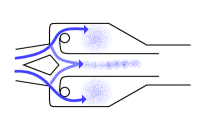Jet engine technologies for interested amateurs
Last Updated: 6 November, 2002
|
What Is The Coanda Effect? The flow of gases is subject to a great many "effects" which have been observed and documented over the years.
One such effect is that observed and documented by a Romamanian by the name of Henri-Marie Coanda in the 1930s. Coanda noted that a stream of fluid or gas will tend to hug a convex contour when directed at a tangent to that surface. You can check this out for yourself by turning on a tap, so that there's a steady but gentle continuous stream of water flowing. Now bring the back of a spoon into slight contact with the stream and you'll find that the water will no longer fall straight down but actually stick to the curve of the spoon. This rather unintuitive behavior is the Coanda effect in action. It's pretty easy to understand why a flow would be deflected by a concave curve -- the curve will "push" the flow around the corner -- but isn't it odd that the flow seems to be pulled by a curved surface? My own experiments indicate that a single curved surface will deflect a gasflow by a maximum of about 90 degrees -- after which the flow detaches itself from the curve and travels at a tangent to that curve.
How Can This Be Used In A Pulsejet? Indeed, some of the gasflows within my X-Jet engine rely on the Coanda effect so I thought I'd have a think about how the same effect could be applied to more traditional pulsejet engines. Here's what I've come up with:
The Combustion Phase When the air-fuel ignites, some of the hot gases travel out the tailpipe through the expected route -- but those which would be expected to travel out the intake tube (the left-most arrows) are subjected to the Coanda effect produced by the curved path at the mouth of that internal tube. These gases are further coerced down the tailpipe by another of these great "effects" first observed by (and named after) Mr Bernoulli. Because the gases which enter the tailpipe through the outermost path are travelling very fast, they produce a low-pressure area at the right-hand end of that internal tube. The flow entering the front of the internal tube is thus further encouraged to exit through the rear of the engine thanks to this area of low-pressure. Now, let's see what happens during the intake phase of the engine's operation.
The Intake Phase Note that the diamond shape has sharp edges, not curves. If we made this a nicely curved shape then the Coanda effect would work against us by pulling the incoming air back towards the center of the internal tube. By using a sharp edge, the flow will separate and virtually all of it will travel outwards and into the combustion area. However, because a vortex will form on the back-side of this diamond, a small amount of the incoming air will travel into the internal tube -- but that's not going to be a problem because it will simply become extra mass for the engine to eject later. The fuel will be injected at the point where the incoming air passes over the circle at the front of the combustion area. When the fresh air-fuel mixture ignites, the whole cycle repeats again.
Will It Work? To be honest -- I don't know, I haven't built it yet. Based on my experience with the design of pulsejets I'd have to say that there's probably a devil in the detail. The precise angles and radius of the curves involved need to be established by a little calculation and much empirical work, but I see no reason why the basic theory won't hold up. Now this isn't going to stop all the hot gases from trying to exit through the intake tube -- no valveless system can actually do that but I hope that it could provide enough flow control to allow such an engine to provide a good measure of static thrust. The advantage of not bending the engine in half and facing the intake in the same direction as the exhaust is that you can then take much more advantage of ram-effect to increase the power of such an engine when it is operating at high speed. If anyone wants to play with this idea, please do so -- and send me the results of your experimentation. UPDATE: I've since verified the basic integrity of this design using my 2D flow modeling rig.
|
|

 In many cases, the person responsible for making the first observations
of a particular effect has their name attributed to it and then they
become famous -- albeit only amongst those who are interested in such things.
In many cases, the person responsible for making the first observations
of a particular effect has their name attributed to it and then they
become famous -- albeit only amongst those who are interested in such things.

 The incoming air is deflected towards the outside path by way of the
diamond shape in the middle of the intake tube.
The incoming air is deflected towards the outside path by way of the
diamond shape in the middle of the intake tube.